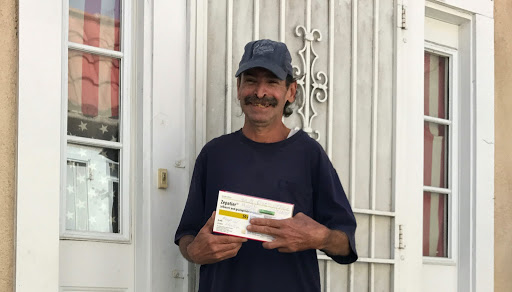Housing Options
Figure 34. A patient housed in scattered-site permanent supportive housing achieves the stability needed to finally treat Hepatitis C. Taken by Dr. Coley King of Venice Family Clinic.
Project-based Permanent Supportive Housing: Residents live in private apartments within a complex of apartments dedicated to housing their peers. Social services and supportive services are co-located, and may be run by a housing agency or an independent agency. Some or all rent may be subsidized. Residents must be able to live independently despite remote support from social services.
Scattered-Site Permanent Supportive Housing: Residents use income from work, pensions, or Supplemental Security Income or Social Security Disability Income (SSI/SSDI) in combination with Section 8 vouchers (administered by HUD) to rent housing on the market, as other renters would do. Residents with Section 8 pay reduced rent—30% of their SSI/SSDI income or other county public assistance income. Social workers and case managers travel to residents’ homes from their agencies to continue support. Residents must be able to live independently despite remote support.
Board and Care (Also known as Community Care Facilities in California): Residents live in a state-licensed facility or section of an individual’s home and are provided ongoing, non-nursing support. Residents must be able to complete activities of daily living (ADLs) and need a source of income to pay rent (SSI/SSDI). States often have age restrictions on who can qualify with specific facilities designated for seniors. Board and Care can be a good alternative to costly care in a Skilled Nursing Facility (SNF) if the patient becomes more independent.
Motels: Motels and hotels can be useful for medical respite, a bridge to other forms of housing, or during local emergencies. Policies and funds for motel stays vary widely by agency and geography. For example, California sheltered many homeless individuals in hotels during the COVID-19 pandemic.
Shared Housing: A third party, often a housing agency, arranges for program participants to share living space and expenses. Shared housing can decrease the cost of housing in large urban centres but may be unsuitable for some people. There can be privacy downsides.
Sober Living: Housing attached to a substance use treatment program. This may house participants for up to six months, a longer period of time than some shelters, but should not be considered housing “placement”, or a viable long-term housing solution.
Family Reunification (as a housing alternative): In some cases, reuniting a patient with family members may be an alternative to navigating the housing system.
